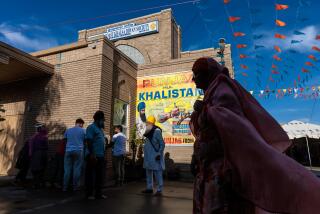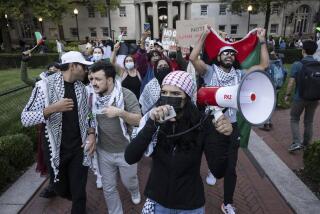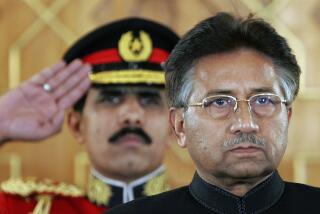Pakistan’s Muslim Schools Preach Dark View of U.S.
- Share via
PESHAWAR, Pakistan — By midmorning, classes were well underway for the 250 boys and young men at the Rahatabad religious school, a spartan two-story building tucked into a side street of this sprawling frontier city.
Koranic verses floated from the bare, concrete-floor classrooms, exuding a tranquillity that belied the scene’s larger significance: Collectively, the Rahatabad school and others like it across the Muslim world make up an unlikely but vital battleground in America’s new war against terrorism.
The messages of hate that come from these institutions fill earnest young minds with a frightening picture of America as a sinister, uncaring center of evil that is mesmerized by Israel and is the enemy of Islam. All too often, the result of this teaching is a mind-set that can easily accept violence as a response to perceived injustice.
Those who know the Rahatabad school say the dark image presented of the United States is never challenged or debated. It is driven home relentlessly to the 16-to-24-year-olds during the eight years they require to graduate.
“Everything you do is wrong. America’s wealth, its resources are in the hands of Jews, and they are not using it for a noble cause,” said Syed Inayetullah, an 18-year-old Pakistani in his third year at the school.
Combating the message of these religious schools--known by their Arabic name, madrasas--will probably require more than the bravery and superior military might that have brought America victory in earlier conflicts. Political analysts believe it is a fight that will require patience, dialogue, new ideas and new attitudes on both sides rather than cruise missiles and F-16s.
These fountains of anti-Americanism are more than mere trouble for the United States. They loom as a serious threat to Pakistan’s domestic stability, as President Gen. Pervez Musharraf prepares to distance himself from Afghanistan’s Taliban leaders and work with the United States to capture Osama bin Laden, the prime suspect in the World Trade Center and Pentagon attacks. Bin Laden is believed to live under the Taliban’s protection in eastern Afghanistan.
Pakistan Groups Promise Protests
Religious-based parties in the country, who draw support from the madrasas, have pledged mass protests to oppose any Pakistani assistance for the U.S.
An American visitor’s discussion with students and faculty at the Rahatabad school this week produced an array of cast-iron anti-U.S. views punctuated by occasional stunning conclusions about last week’s terrorist attacks. The school’s principal, Moulana Sayed Zainulariffeen, agreed with Western assessments that the attack was a carefully planned conspiracy, but there all similarity ended.
“In our opinion, this was all done by the Jews to turn American power against the Muslim people,” he said.
The Muslim cleric described Bin Laden as a hero, demanded evidence of his involvement in the attacks, then embarked on a list of American wrongs against Muslims. Even U.S. backing of Muslim resistance groups in Afghanistan in their war against the Soviets throughout the 1980s was turned into a plot.
“The Americans used the blood of good Muslims to contain Russia’s expansion, and then they left,” Zainulariffeen said.
His students, mainly poor Afghans and Pakistanis, share those sentiments.
Madrasas a Fixture of Islamic World
The madrasa is 1,300 years old--as old as the Muslim world. But its role in preaching a narrow ideology is new, according to Anis Ahmad, a well-known religious scholar and dean of the social sciences department at the International Islamic University in Islamabad, Pakistan’s capital.
Anis noted in an interview that these schools have been a part of Islam since the time of the prophet Muhammad and had once worked at the cutting edge of knowledge with curricula that mixed science and human values. But in recent decades, the spread of Islamic fundamentalism has spawned a new kind of madrasa, one that offers young Muslim men a strict religious curriculum along with a political viewpoint that paints Muslims as the oppressed victims of Israel and the West, especially the United States.
“Our tragedy is that our [madrasas] have gotten restricted to a few narrow issues,” Anis said.
Nowhere is this phenomenon more visible than in Peshawar, the provincial capital and commercial center of Pakistan’s northwest frontier region. Here, the number of religious schools has exploded, fueled first in the 1980s by the fundamentalist resistance groups fighting the Soviet invaders of neighboring Afghanistan, then a decade later by the fervor of that country’s Taliban government.
Indeed, the Taliban’s leaders went directly from religious schools in Pakistan to the Afghan battlefields and eventual power.
Jahseen Ullah Khan, chief coordinator of the National Research and Development Foundation, a Peshawar-based privately funded group pushing educational reform, said the number of religious schools in the Peshawar area had jumped from 13 in 1980 to 87 by the end of 1998.
He estimated the religious school student population at around 18,000 in Peshawar.
Students, frequently poor refugee children with no other chance at advanced education, need know only how to read and write to gain admission to the intense eight-year course.
Musharraf’s government has cited as a priority the task of broadening the curricula and easing the isolation of these schools. But so far there has been little progress, often making a madrasa the only choice.
School Environment Isolates Students
Those who know these religious schools say they provide a near-perfect environment for indoctrination. Students are clothed, fed and housed at the school, so they rarely come in contact with outsiders, let alone outside divergent opinion. There is no contact of any kind with women. They are sometimes in effect given to the schools by their impoverished families, and from that day rarely see parents or brothers and sisters again.
“They are carefully isolated,” Jahseen said. “They are taught only to follow the elders and never to question them. Their education is a one-sided affair.”
For their first three years, students memorize the Koran, then spend five years carefully learning to interpret it.
Political lessons, those familiar with the schools say, come not so much in formal classroom lectures but informally and also at Friday prayers, which frequently turn into a political lesson, usually against America. The ingredients of those lessons often are filled with events of the day.
Deaths of Palestinian children and stone throwers, targeting of Palestinian leaders and incursions into Palestinian areas are minutely covered by the mass media. For those too poor to read or watch broadcasts, religious teachers and prayer leaders spread a message of oppression by America and Israel--downplaying injuries suffered on the other side.
In Pakistan, anti-Americanism is further fueled by U.S. sanctions and Washington’s perceived indifference to the conflict between India and Pakistan over Kashmir, noted Ayesha Haroon, a senior editor of the national English language daily, the Nation.
Many See U.S. at War With Their Religion
In this atmosphere, it is easy for a madrasa instructor’s accusation of American complicity in violence against Muslims worldwide to become the accepted truth, so that even educated people begin to see the U.S. government at war with them and their religion.
It is a mind-set that will undoubtedly be a problem for U.S. planners of a response to last week’s terrorist attacks, because public opinion in Muslim and Arab countries is predisposed to distrust and oppose anything said or done by the United States.
Haroon said she is bothered that some American officials seem blind to the anger and the reasons it has built up.
“One way for America to respond is with a huge amount of violence,” she said. “And the other way is to change the foreign policy, make a shift, realize what is really going on.”
More to Read
Sign up for Essential California
The most important California stories and recommendations in your inbox every morning.
You may occasionally receive promotional content from the Los Angeles Times.










